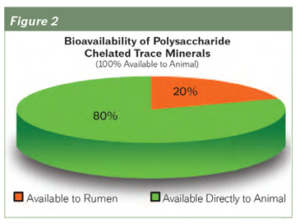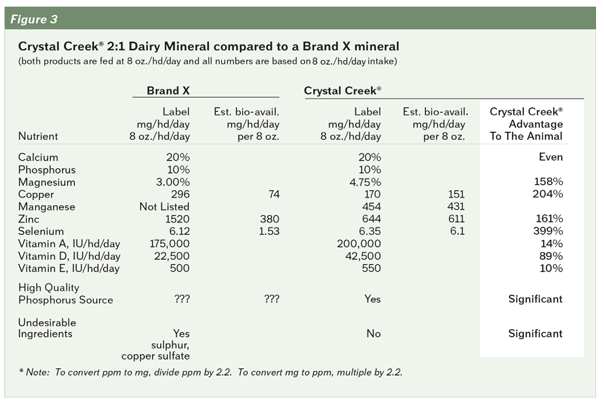Interpreting The Value Of A Livestock Mineral
Click here to view as a pdf: Interpreting The Value Of A Livestock Mineral
Customer Favorite This article was originally published in the April 2012 Issue of the Crystal Creek® Newsletter
The goal of this article is to offer insight in determining the value of a livestock mineral. The value can be determined by combining the information supplied on the label and visual observation of the mineral itself, along with some basic ingredient knowledge. A critical analysis will consider ingredient quality, nutrient bioavailability and possible negative, unintended consequences associated with poor ingredient quality or inappropriate formulation techniques.
Much of the information needed to develop an accurate assessment of a product’s value is not found on the label. With the information contained in this article, any dairy producer can become a more educated consumer with regards to livestock minerals and their value to the dairy. Understanding the value of a mineral supplement at a level deeper than the “price per bag” affords producers the opportunity to evaluate the mineral’s value based on cost per head per day, as well as how it may support animal performance and the operation’s overall profitability.
The information contained on a feed label is regulated by each state. However, most states use the Association of American Feed Control Officials (AAFCO) as a model for feed label design. For non-medicated feeds, AAFCO requires the following information on each product: brand name, product name, purpose statement, guaranteed analysis, list of ingredients, directions for use, warnings or cautions, name and address of the manufacturer and a quantity statement.
The List Of Ingredients
A basic assessment of a product’s value begins with the list of ingredients. This list can give insight into the quality of the ingredients used to make the product, their bioavailability and reveal anything potentially harmful or unnecessary in the product. At first glance, some products list of ingredients may seem daunting to analyze. Often the list of ingredients is long. Some ingredients have scientific chemical names written in fine print. Use the tips below to help work your way through a mineral label to determine its true value.
Tip #1: Industry standards suggest ingredients be listed in the order of the volume in which they occur in the formula, i.e. highest to lowest.
However, this recommendation is not always followed. Do not be fooled into believing that just because an ingredient is found in the first part of the ingredient list that it is a higher volume ingredient.
Tip #2: Be cautious of products with extremely long lists of ingredients.
Some companies add low levels of multiple, unnecessary ingredients to create an ingredient list that gives the impression that the producer is receiving a high value product. Often these extra ingredients are added at levels so low they have little to no significant benefit. Companies will also add unneeded ingredients solely to complicate the label and confuse the consumer. It is important to note that mono-gastric animals, such as swine, poultry and equine, typically require a greater number of ingredients to balance their nutritional requirements when compared to ruminants.
Categories Of Ingredients
Every livestock mineral is composed of ingredients that fall into one of the following categories: macro-minerals, trace minerals, vitamins, high function additives, fillers, flavoring agents, non-essential extra ingredients and ingredients that can be counter-productive.
Macro-minerals
Macro-minerals are minerals required by the animal in higher volumes. Ingredients such as monocalcium phosphorus, dicalcium phosphorus, calcium carbonate, magnesium oxide or sulfate, potassium chloride, potassium carbonate and sodium chloride are examples of ingredients that are intended to provide key macro-minerals such as phosphorus, calcium, magnesium, potassium and sodium.
Tip #3: Review the ingredient list for highly bioavailable forms of macro and trace minerals. The Crystal Creek® line of livestock minerals are built on a sound foundation of high quality phosphorous sources.
Monocalcium and dicalcium are typical sources of both phosphorus and calcium in livestock mineral, but there can be a wide range of quality.
Trace Minerals
Trace minerals are minerals required in lower volumes in the animal’s diet. There are many trace minerals in livestock nutrition, but the most commonly supplemented are zinc, manganese, copper and selenium. There are several categories of trace mineral sources available and each type has a different level of bioavailability to the animal (Figure 1).
Oxide trace minerals are low in bioavailability and can be reactive with other nutrients in the diet. Many oxide trace minerals are anywhere from 0-20% bioavailable to the animal. When oxides are fed at high levels they can compromise digestive efficiency and may act as free radicals in the body. Mineral products containing oxide forms of trace minerals are suggestive of a poor quality mineral source.
Sulfate trace minerals have a moderate level of bioavailability, but can still be reactive to other nutrients in the diet. Sulfate trace minerals have anywhere from 0-50% bioavailability. The level of reactivity can vary depending on the density of other reactive nutrients, formulation style and ambient humidity.
Tip #4: Oxide and sulfate trace minerals can kill rumen bacteria.
Review your mineral label and see if there is zinc oxide or copper sulfate in the ingredient list. Copper sulfate is commonly used in foot baths to kill bacteria that are responsible for hairy heel warts. Although the levels of copper sulfate used in typical mineral formulas is low, it reveals that the company manufacturing that product is more concerned about using low cost, low quality ingredients and is not focused on including ingredients that support optimum rumen function or promotion of digestive micro-flora.
Chelated trace minerals are typically much higher in bioavailability. Chelation means that the trace mineral metal ion (zinc, copper or manganese) has been combined with two other non-metal nutrient compounds to reduce unwanted reactivity and improve bioavailability. There are several forms of chelated trace minerals.
- Metal Amino Acid Chelates: use an amino acid (like methionine) to attach to a trace mineral ion like zinc, manganese or copper and are virtually 100% bioavailable to the animal. However, they are generally not available to rumen microbes. Consequently, it is not advised to use 100% trace mineral supplementation with just metal amino acid chelates for ruminant mineral supplements. Many mineral products contain a ratio of 25 to 30% metal amino acid chelates with the rest being oxides and/or sulfates. A discerning consumer will realize that this ratio is not specified on the product label and should ask their supplier to confirm the ratio of metal amino acid chelates to sulfates/oxides.
- Proteinated Trace Minerals: are chelated trace minerals that use a larger protein molecule to attach to trace mineral ions (zinc, manganese or copper) to accomplish a similar result as the metal amino acid chelates. Note the range of bioavailability on (Figure 1).
- Polysaccharide Trace Minerals: are chelated trace minerals that attach a carbohydrate molecule to a trace mineral ion (zinc, manganese or copper). The polysaccharide chelated trace minerals have the benefits of chelation protection while at the same time are available for rumen microbe use. The rumen microbes utilize the trace minerals for their own growth and reproduction. When the microbes pass down the digestive tract the ruminant can obtain the trace minerals when the microbes are digested. This results in a high net bioavailability to the ruminant, excellent rumen microbe support and an efficient form of trace mineral delivery to the animal (Figure 2).
Tip #5: There is no need to have low quality oxide and sulfate trace minerals when adequate levels of polysaccharide chelated complexes of zinc, manganese or copper are the sole source of supplemental trace minerals. The highest quality mineral supplements will have 100% of the trace minerals in the form of polysaccharide complexes (with the exception of cobalt sulfate).
Vitamins
Tip #6: Of the three main supplemental vitamins, A, D, and E; vitamin E is the most expensive. A low quality mineral will often include excessively high levels of vitamins A and/or D to distract from a lower, possibly inadequate level of vitamin E.
Harmful Or Counterproductive Ingredients
These are ingredients that may have minor beneficial function but also have larger unintended negative consequences associated with their use. Many times these counter-productive ingredients are highly reactive and tie-up a wide range of nutrients in the general diet such as macro minerals, trace minerals, vitamins, amino acids and carbohydrates.
Tip # 7: Livestock minerals containing the following ingredients should be avoided: charcoal, humates, diatomaceous earth, raw sulfur, ferrous oxide (iron oxide), moderate to high levels of clays and high levels of oxide or sulfate trace minerals.
Tip #8: Visually inspect your current mineral product. Is it reddish in color?
If so, there is a likelihood that excessive levels of ferrous oxide (iron oxide) have been intentionally added to the formula. Iron oxide is a highly reactive compound that decreases nutrient bioavailability in the diet. So why is it added to many mineral products? Some feed companies add ferrous oxide to give their mineral a consistent reddish color in an effort to make it more visually appealing to the consumer. A company that sells a mineral with ferrous oxide added for color consistency is using it as a marketing tool, but has created a product with a blatant and insulting disregard to the animal’s nutritional needs and the producer’s profitability. Minerals formulated like this typically have a low price per bag but deliver poor nutritional value.
Fillers
Tip #9: Inspect the ingredient list for the term ‘plant protein products’.
This is a general term used to cover up the addition of a wide range of extenders or fillers. The most commonly used plant protein filler is distillers grains.
The following chart (Figure 3) compares a typical lower cost Brand X livestock mineral to the Crystal Creek® 2:1 Dairy Mineral. Note the significant advantage the Crystal Creek® mineral has in bioavailability over the brand X. The Brand X mineral is $282.00/ton cheaper. However, when compared on nutrient delivery to the animal through higher quality, higher bioavailable ingredients it becomes obvious that the Crystal Creek® 2:1 is a better value.
In summary, evaluate your current livestock mineral using the 9 tips presented above and evaluate the label in an effort to critically determine the quality and value of that product. A high quality livestock mineral will not try to confuse you with a long list of excessive ingredients and complicated scientific names. Review the source of trace minerals and look for exclusively polysaccharide trace mineral fortification. Visually inspect the mineral and be suspicious of a reddish colored product that likely has raw ferrous oxide added. Critically evaluate the levels of vitamins A, D and E and look for the presence of cheap plant protein based fillers. By using these 9 tips to evaluate your current livestock mineral, you have begun the process of better understanding how to properly evaluate your livestock mineral program beyond the common “price per bag” approach and focus more on comprehensive value.
If you have any questions or would like to discuss livestock mineral further, please feel free to call Crystal Creek® and talk with one of our nutritionists. Crystal Creek® livestock minerals are among the finest in the industry and give you the best value for your dollar. Your cows and your pocket book will agree!



